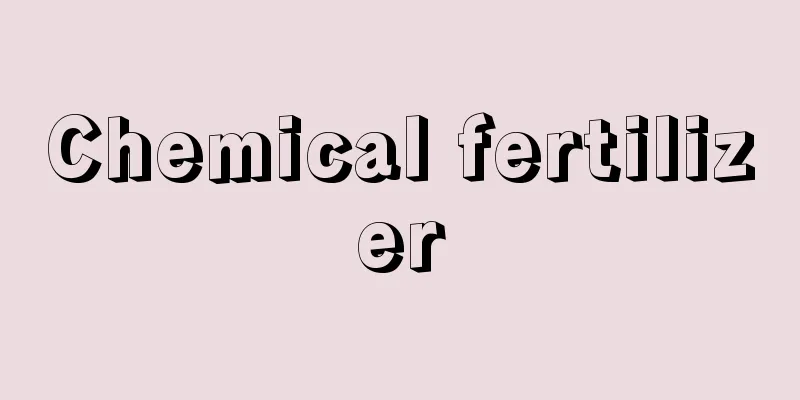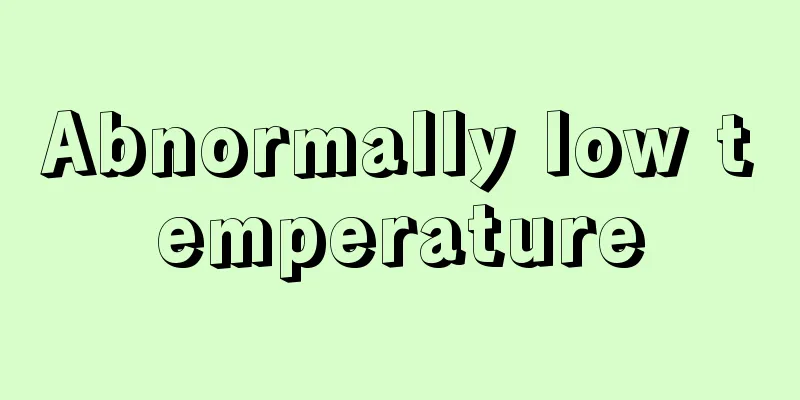Chemical fertilizer

|
Fertilizers are produced by chemical methods and were formerly called artificial fertilizers. The name corresponds to self-sufficient fertilizers such as manure, and organic fertilizers made from plants and animals, such as oil cake and bone meal. The beginning of chemical fertilizers is thought to be in 1839, when the German scientist Liebig reacted with bone meal and sulfuric acid to produce water-soluble phosphoric acid, and confirmed its effectiveness as a fertilizer. In Japan, ammonium phosphate and calcium superphosphate were first produced and used on a trial basis in 1875 (Meiji 8). Now that the chemical industry has developed, the majority of fertilizers consumed in Japan are chemical fertilizers. The progress of modern agricultural technology, which is characterized by high productivity and efficiency, would be unthinkable without chemical fertilizers. If we look at the trends in the use and consumption of chemical fertilizers in Japan, divided into the main crop of paddy rice and other crops, we see that paddy rice was not affected much by the oil crisis and increased every year until 1987. This trend was due to the development and spread of varieties that produce high yields with high nitrogen fertilizers and the implementation of a high rice price policy by the government. However, when the price of rice was reduced in 1987, the amount of chemical fertilizers used also decreased sharply. Looking at this by the components of nitrogen, phosphorus, and potassium (potassium), nitrogen was previously the most common, followed by potassium and phosphorus. However, since 1969, the order has been phosphorus, nitrogen, and potassium. This is due to the fact that a lot of phosphorus was used to reduce damage from cold weather. For crops other than paddy rice, the amount used increased every year until 1973. However, the oil crises that occurred in 1973 and 1978 had a strong impact on the consumption of chemical fertilizers, causing a sharp drop each time, but it has since recovered and has remained roughly flat, with increases and decreases. [Yuki Koyama] kindsChemical fertilizers are classified from various perspectives, such as composition, form, and application method. Fertilizers that contain only one of the three major elements are classified as nitrogen fertilizers, phosphate fertilizers, or potassium fertilizers, depending on the main component, while those that contain two or more are classified as compound fertilizers. In addition, there are many other types, such as fertilizers whose main components are lime, silica, magnesia (magnesium oxide), and manganese, which are effective for crops, fertilizers that are a mixture of several trace elements, fertilizers that contain pesticides, slow-release fertilizers with adjusted fertilizer activity, and coated fertilizers. Fertilizer components are more effective for crops when applied in appropriate combinations rather than individually, and because they are easy to handle, the proportion of fertilizers used as single fertilizers is low, with chemical fertilizers and compound fertilizers accounting for the majority of application. Also, the use of powdered fertilizers has shifted to granular fertilizers. In addition to these solid fertilizers, the use of liquid fertilizers made by conveniently mixing various components for home gardening and farm cultivation facilities is increasing. [Yuki Koyama] Characteristics and problems of chemical fertilizersThe reasons for the dramatic increase in the use of chemical fertilizers include the following: (1) Because it is mass-produced in the chemical industry, the quality is uniform, the supply is stable, and the price is low. (2) It is more hygienic and easier to use than manure, night soil, green manure, etc. (3) The content of active ingredients such as nitrogen and phosphorus is remarkably high and consistent. (4) Transportation costs are low and storage is easy. (5) Fertilization can be done according to the purpose, with minimal waste. Although chemical fertilizers have the above-mentioned advantages, they also have the following disadvantages: (1) It is easy to get fertilizer burn due to excessive fertilizer use or poor concentration of fertilizer. (2) Care must be taken when mixing, as improper mixing can cause ingredients to escape or increase hygroscopicity. (3) The continued use of large amounts of chemical fertilizers over a long period of time will deteriorate the soil. (4) Crops become weak and susceptible to pests and diseases. (5) There is a risk of environmental degradation, such as polluting rivers, lakes, and groundwater and leading to eutrophication. To eliminate the drawbacks of chemical fertilizers, it is especially desirable to use them in combination with organic materials such as manure, rice straw, and compost (organic fertilizer).Furthermore, fertilizers that contain organic matter and trace elements such as coated fertilizers with adjusted fertilizer effectiveness and fermentation waste liquid, and that compensate for the drawbacks of general chemical fertilizers, are being manufactured, sold, and are beginning to become more widespread.However, even today, the majority of chemical fertilizers are still inorganic, made from raw materials such as ammonium sulfate, ammonium chloride, calcium superphosphate, and potassium sulfate (potassium sulfate). After the Second World War, Japanese agriculture, which was aimed solely at high production efficiency, led to the harmful effects of excessive use of chemical fertilizers and pesticides, which deteriorated the soil and also threatened sustainable agricultural production in terms of the environment and resources. In response to this situation, the Basic Agricultural Law was replaced in 1992 with a new "Direction for New Food, Agriculture, and Rural Policy," which called for the establishment of sustainable agriculture that took into consideration reducing the environmental burden caused by chemical fertilizers and other such products. In 1999, the Basic Law on Food, Agriculture, and Rural Areas was enacted, which will serve as a guideline for agricultural policy in the 21st century, and the shift to so-called "environmentally friendly agriculture" was further promoted. In the future, it will also be necessary to give even greater consideration to safety, security, and health. [Yuki Koyama] "Fertilizers and Environmental Conservation: The Impact of Chemical Fertilizers and the Fertilization of Waste" edited by Hayase Tatsuro, Ando Junpei, and Koshino Masayoshi (1976, Soft Sciences)" ▽ "Chemical Fertilizers, New Edition, by Kubo Kiichiro and Arai Yasuo (1977, Dainippon Tosho)" ▽ "Fertilizer Handbook, 5th Edition, edited by Date Noboru and Shiozaki Hisao (1997, Rural Culture Association)" ▽ "The Green Revolution and Its Violence, by Vandana Shiva, translated by Hamatani Kimiko (1997, Nihon Keizai Hyoronsha)" ▽ "Environmentally Conserving Agriculture: 10 Years of Efforts and Aims" edited by the National Federation of Agricultural Cooperative Associations and the National Central Union of Agricultural Cooperative Associations (2002, Ie no Hikari Kyokai)" ▽ "Fertilizer Yearbook, various editions, edited by the Fertilizer Association Newspaper Department (Fertilizer Association)" [Reference items] | | | | | | | |©Shogakukan "> Chemical fertilizer classification Source: Shogakukan Encyclopedia Nipponica About Encyclopedia Nipponica Information | Legend |
|
化学的手法により製造された肥料のことで、古くは人造肥料ともよばれた。堆厩肥(たいきゅうひ)などの自給肥料や油かす、骨粉などの動植物を原料とした有機質肥料に対応した呼び名である。 化学肥料の始まりは、1839年にドイツのリービヒが、骨粉に硫酸を作用させ水溶性リン酸をつくり、これが肥料として有効であることを確かめたときと考えられる。日本では、1875年(明治8)リン酸アンモニウムと過リン酸石灰がつくられ試用されたのが初めである。化学工業が発達した現在、日本で消費されている肥料の大部分は化学肥料によって占められる。高生産、高能率な現代の農業技術の進歩は、化学肥料なしにはとうてい考えられない。 日本の化学肥料の施用・消費量の推移を主作物の水稲と、それ以外の他作物とに分けてみてみると、水稲ではオイル・ショックの影響をあまり受けずに1987年(昭和62)まで毎年増加した。こうした傾向は窒素の多肥で高い収量をあげる品種の開発普及と、政府による高米価政策が実施されたことなどによる。しかし、1987年米価が引き下げられると同時に化学肥料の施用量も急激に減少した。これを窒素、リン酸、カリ(カリウム)の成分別にみると、以前は窒素がもっとも多く、ついでカリ、リン酸の順であった。しかし1969年以降はリン酸、窒素、カリの順になっている。これは冷害の軽減対策にリン酸が多く施用されたことなどによる。水稲を除く他作物では1973年まで施用量は毎年増加した。しかし、1973年、1978年に発生したオイル・ショックは化学肥料の消費量に強く影響し、その都度激減したが、その後は回復し、増減を繰り返しながらおおむね横ばいの傾向で推移している。 [小山雄生] 種類化学肥料は、組成、形態、施肥法など種々の観点から分類される。肥料三要素のうちの1種類のみを含むものは、その主成分によって窒素肥料、リン酸肥料、カリ肥料に分類され、2種類以上を含有するものは複合肥料に分類される。そのほか、作物に有効な石灰、ケイ酸、苦土(酸化マグネシウム)、マンガンを主成分とするものや、数種の微量要素を混合した肥料、農薬を混入した肥料、肥効を調節した緩効性肥料やコーティング肥料など多くの種類がある。 肥料成分は、単独に施用するよりも適切な割合で複合して与えたほうが作物にとっていっそう効果があることと、取扱いが便利であることから、単肥で使用される割合は少なく、化成肥料や配合肥料が施用量の大部分を占めている。また、粉末での使用から、粒状に成形されたものへと主体はかわってきている。さらにこのような固形のものばかりでなく、家庭園芸用や農家施設栽培用に種々の成分を好都合に調合した液肥の使用が増えつつある。 [小山雄生] 化学肥料の特徴と問題点化学肥料の使用量が飛躍的に増大した理由としては次のような点があげられる。 (1)化学工業として大量生産されるので、品質が均一で、供給も安定しており、また価格も安い。 (2)堆厩肥、下肥、緑肥などに比べて衛生的であり、使いやすい。 (3)窒素、リンなど有効成分含量が著しく高く、また一定している。 (4)輸送コストが低く、貯蔵しやすい。 (5)目的に沿った施肥ができ、むだも少ない。 化学肥料は以上のような特長を備えているが、欠点としては以下の点があげられる。 (1)肥料のやりすぎや濃度障害による肥(こえ)焼けをおこしやすい。 (2)混合の仕方を誤ると、成分が逃げたり吸湿性を増したりするので注意が必要である。 (3)化学肥料のみを大量に長期間にわたって使用し続けると土壌が悪化する。 (4)農作物が軟弱となり病害虫にかかりやすくなる。 (5)川や湖沼、地下水を汚染し、富栄養化を招くなど環境を悪化するおそれがある。 化学肥料の欠点を取り除くためには、堆厩肥、稲藁(いねわら)、コンポスト(有機質肥料)などの有機資材との併用がとくに望まれている。さらに肥効を調整した被覆肥料、発酵廃液などの有機物や微量要素を含有し、一般の化学肥料の欠点を補った肥料も製造、販売され、普及し始めてきている。しかし現在でも化学肥料の主体は、まだ硫安、塩安、過リン酸石灰、硫酸カリ(硫酸カリウム)などを原料とした無機質のもので占められている。 高い生産効率のみを目的とした第二次世界大戦後の日本農業は、化学肥料と農薬の多投という弊害を招き、土壌を悪化し、また環境、資源の面からも持続的な農業生産が脅かされるようになった。このような状況への対応から、1992年(平成4)農業基本法にかわり「新しい食料・農業・農村政策の方向」が新しく打ち出され、化学肥料などによる環境への負荷の軽減に配慮した持続的農業の確立がうたわれた。また、1999年には21世紀の農業政策の指針となる食料・農業・農村基本法が成立し、いわゆる「環境保全型農業」への転換がいっそう推進されることになった。今後はさらに安心・安全・健康への配慮も必要となってきている。 [小山雄生] 『早瀬達郎・安藤淳平・越野正義編『肥料と環境保全――化学肥料の影響と廃棄物の肥料化』(1976・ソフトサイエンス社)』▽『久保輝一郎・荒井康夫著『化学肥料』新版(1977・大日本図書)』▽『伊達昇・塩崎尚郎編著『肥料便覧』第5版(1997・農山漁村文化協会)』▽『ヴァンダナ・シヴァ著、浜谷喜美子訳『緑の革命とその暴力』(1997・日本経済評論社)』▽『全国農業協同組合連合会・全国農業協同組合中央会編『環境保全型農業――10年の取り組みとめざすもの』(2002・家の光協会)』▽『肥料協会新聞部編『肥料年鑑』各年版(肥料協会)』 [参照項目] | | | | | | | |©Shogakukan"> 化学肥料の分類 出典 小学館 日本大百科全書(ニッポニカ)日本大百科全書(ニッポニカ)について 情報 | 凡例 |
<<: Chemical physics - kagakubutsurigaku (English spelling) chemical physics
>>: Price display - Price display
Recommend
bartracery
…Until the 12th century, plate tracery, a type of...
serra
…These mountains are not steep like the mountains...
Dortmund-Ems Canal - Dortmund-Ems Canal
The canal stretches 269 km from Dortmund in centra...
Foundling - Kiji
〘 noun 〙 Abandoned child. Abandoned. ※From "W...
Grandite
…Most natural garnets are thought to be complex s...
Blower
… Although there is little difference between the...
CAT - CATV
CATV stands for cable television. It is a service ...
Soft currency
…In modern Japan, the issuance of standard and su...
Okuetsu
...In the age of high-speed transportation, its i...
Delay of graduation
At a credit-based educational institution, remaini...
Jozan
[1] [Name] A shrub of the Saxifragaceae family. Na...
Elam
...However, the weight of English in university e...
Smoke tree
A deciduous shrub or small tree of the Anacardiace...
Educational background
It refers to which stage of education (primary, se...
Tourist Farm
This refers to a farm that provides payment to thi...









